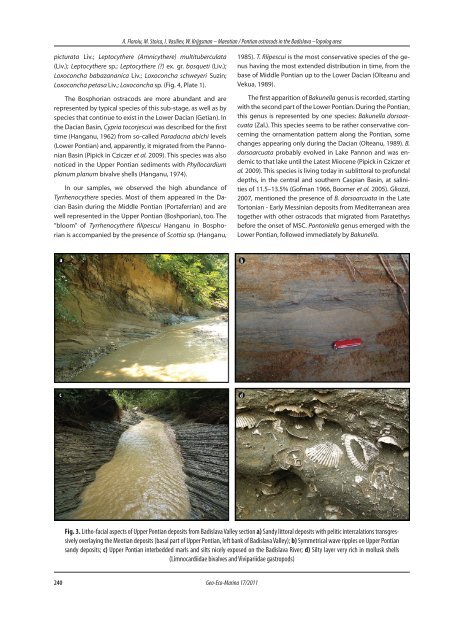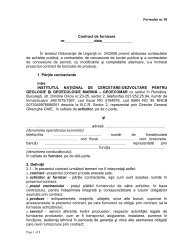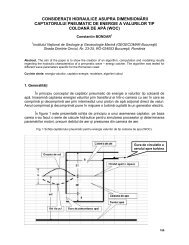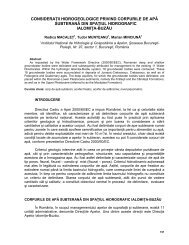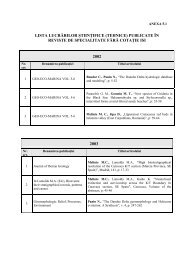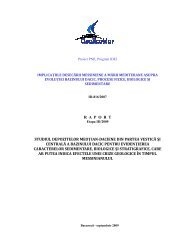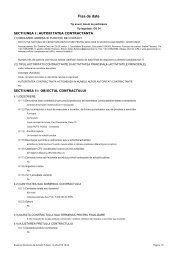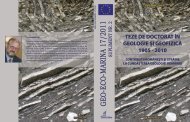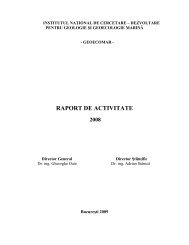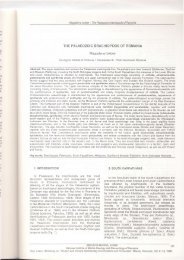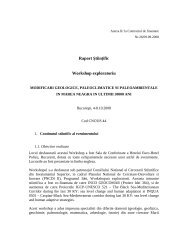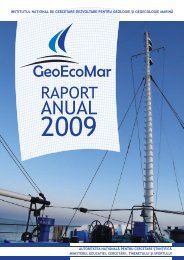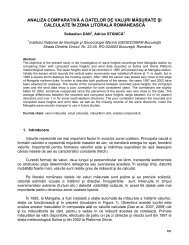Maeotian / Pontian ostracods in the Badislava ... - GeoEcoMar
Maeotian / Pontian ostracods in the Badislava ... - GeoEcoMar
Maeotian / Pontian ostracods in the Badislava ... - GeoEcoMar
You also want an ePaper? Increase the reach of your titles
YUMPU automatically turns print PDFs into web optimized ePapers that Google loves.
A. Floroiu, M. Stoica, I. Vasiliev, W. Krijgsman – <strong>Maeotian</strong> / <strong>Pontian</strong> <strong>ostracods</strong> <strong>in</strong> <strong>the</strong> <strong>Badislava</strong> –Topolog area<br />
picturata Liv.; Leptocy<strong>the</strong>re (Amnicy<strong>the</strong>re) multituberculata<br />
(Liv.); Leptocy<strong>the</strong>re sp.; Leptocy<strong>the</strong>re () ex. gr. bosqueti (Liv.);<br />
Loxoconcha babazananica Liv.; Loxoconcha schweyeri Suz<strong>in</strong>;<br />
Loxoconcha petasa Liv.; Loxoconcha sp. (Fig. 4, Plate 1).<br />
The Bosphorian <strong>ostracods</strong> are more abundant and are<br />
represented by typical species of this sub-stage, as well as by<br />
species that cont<strong>in</strong>ue to exist <strong>in</strong> <strong>the</strong> Lower Dacian (Getian). In<br />
<strong>the</strong> Dacian Bas<strong>in</strong>, Cypria tocorjescui was described for <strong>the</strong> first<br />
time (Hanganu, 1962) from so-called Paradacna abichi levels<br />
(Lower <strong>Pontian</strong>) and, apparently, it migrated from <strong>the</strong> Pannonian<br />
Bas<strong>in</strong> (Pipick <strong>in</strong> Cziczer et al. 2009). This species was also<br />
noticed <strong>in</strong> <strong>the</strong> Upper <strong>Pontian</strong> sediments with Phyllocardium<br />
planum planum bivalve shells (Hanganu, 1974).<br />
In our samples, we observed <strong>the</strong> high abundance of<br />
Tyrrhenocy<strong>the</strong>re species. Most of <strong>the</strong>m appeared <strong>in</strong> <strong>the</strong> Dacian<br />
Bas<strong>in</strong> dur<strong>in</strong>g <strong>the</strong> Middle <strong>Pontian</strong> (Portaferrian) and are<br />
well represented <strong>in</strong> <strong>the</strong> Upper <strong>Pontian</strong> (Boshporian), too. The<br />
“bloom” of Tyrrhenocy<strong>the</strong>re filipescui Hanganu <strong>in</strong> Bosphorian<br />
is accompanied by <strong>the</strong> presence of Scottia sp. (Hanganu,<br />
1985). T. filipescui is <strong>the</strong> most conservative species of <strong>the</strong> genus<br />
hav<strong>in</strong>g <strong>the</strong> most extended distribution <strong>in</strong> time, from <strong>the</strong><br />
base of Middle <strong>Pontian</strong> up to <strong>the</strong> Lower Dacian (Olteanu and<br />
Vekua, 1989).<br />
The first apparition of Bakunella genus is recorded, start<strong>in</strong>g<br />
with <strong>the</strong> second part of <strong>the</strong> Lower <strong>Pontian</strong>. Dur<strong>in</strong>g <strong>the</strong> <strong>Pontian</strong>,<br />
this genus is represented by one species: Bakunella dorsoarcuata<br />
(Zal.). This species seems to be ra<strong>the</strong>r conservative concern<strong>in</strong>g<br />
<strong>the</strong> ornamentation pattern along <strong>the</strong> <strong>Pontian</strong>, some<br />
changes appear<strong>in</strong>g only dur<strong>in</strong>g <strong>the</strong> Dacian (Olteanu, 1989). B.<br />
dorsoarcuata probably evolved <strong>in</strong> Lake Pannon and was endemic<br />
to that lake until <strong>the</strong> Latest Miocene (Pipick <strong>in</strong> Cziczer et<br />
al. 2009). This species is liv<strong>in</strong>g today <strong>in</strong> sublittoral to profundal<br />
depths, <strong>in</strong> <strong>the</strong> central and sou<strong>the</strong>rn Caspian Bas<strong>in</strong>, at sal<strong>in</strong>ities<br />
of 11.5–13.5% (Gofman 1966, Boomer et al. 2005). Gliozzi,<br />
2007, mentioned <strong>the</strong> presence of B. dorsoarcuata <strong>in</strong> <strong>the</strong> Late<br />
Tortonian - Early Mess<strong>in</strong>ian deposits from Mediterranean area<br />
toge<strong>the</strong>r with o<strong>the</strong>r <strong>ostracods</strong> that migrated from Paratethys<br />
before <strong>the</strong> onset of MSC. Pontoniella genus emerged with <strong>the</strong><br />
Lower <strong>Pontian</strong>, followed immediately by Bakunella.<br />
Fig. 3. Litho-facial aspects of Upper <strong>Pontian</strong> deposits from <strong>Badislava</strong> Valley section a) Sandy littoral deposits with pelitic <strong>in</strong>tercalations transgressively<br />
overlay<strong>in</strong>g <strong>the</strong> Meotian deposits (basal part of Upper <strong>Pontian</strong>, left bank of <strong>Badislava</strong> Valley); b) Symmetrical wave ripples on Upper <strong>Pontian</strong><br />
sandy deposits; c) Upper <strong>Pontian</strong> <strong>in</strong>terbedded marls and silts nicely exposed on <strong>the</strong> <strong>Badislava</strong> River; d) Silty layer very rich <strong>in</strong> mollusk shells<br />
(Limnocardiidae bivalves and Vivipariidae gastropods)<br />
240 Geo-Eco-Mar<strong>in</strong>a 17/2011


